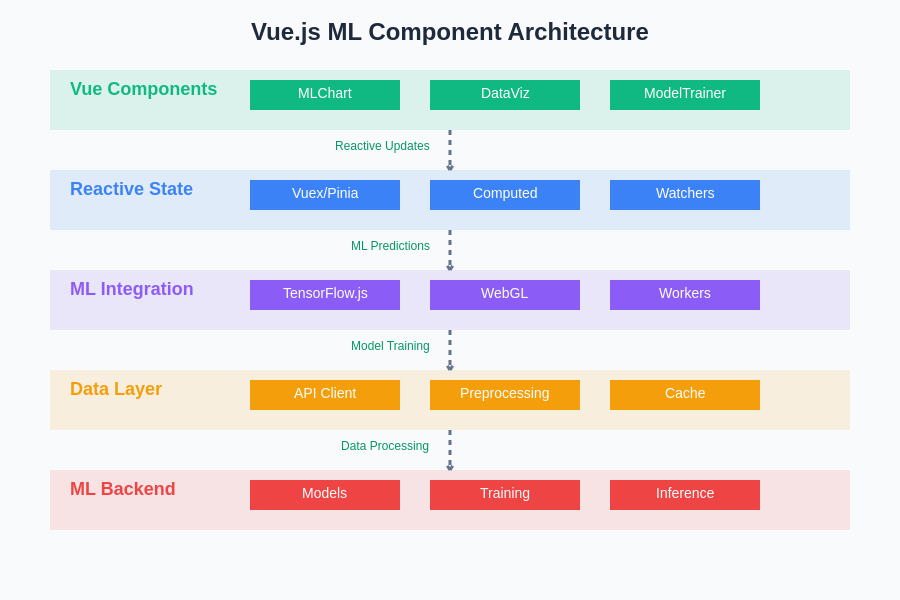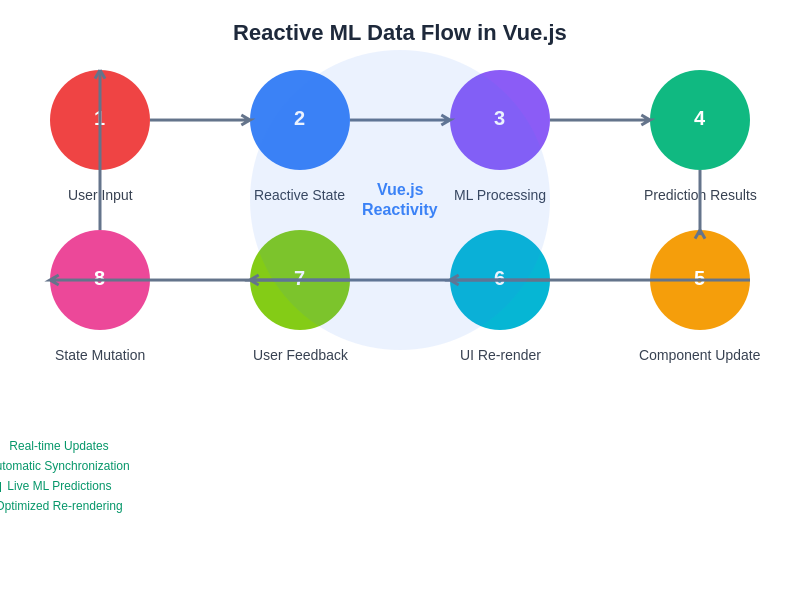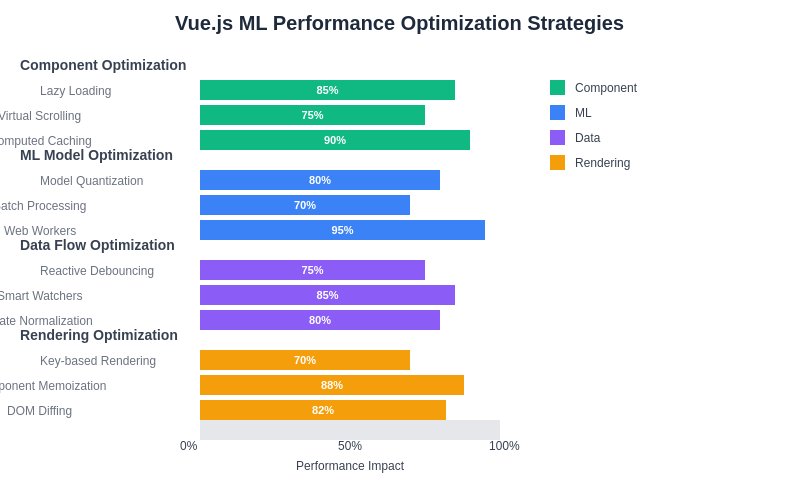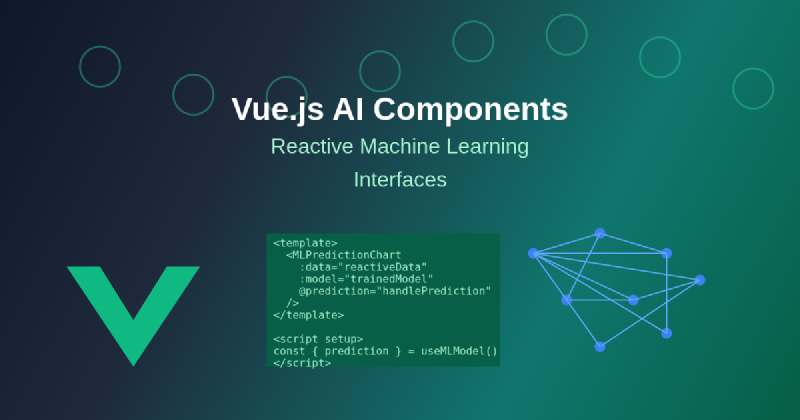The convergence of Vue.js’s reactive programming model with machine learning capabilities has opened unprecedented opportunities for creating intelligent, responsive user interfaces that adapt and learn from user interactions. This powerful combination enables developers to build sophisticated AI-powered components that seamlessly integrate machine learning models into web applications while maintaining the elegant simplicity and reactivity that Vue.js is renowned for. As artificial intelligence becomes increasingly central to modern web applications, understanding how to leverage Vue.js for building reactive machine learning interfaces has become an essential skill for frontend developers seeking to create next-generation user experiences.
Explore the latest AI development trends to stay current with emerging technologies that are transforming how we build intelligent web applications. The integration of machine learning with reactive frontend frameworks represents a fundamental shift in how we approach user interface design, moving from static interactions to dynamic, intelligent responses that enhance user engagement and application functionality.
The Foundation of Reactive Machine Learning
Vue.js’s reactivity system provides an ideal foundation for building machine learning interfaces because it naturally handles the dynamic nature of AI-powered applications where data flows, model predictions, and user interactions must be synchronized in real-time. The framework’s reactive data binding ensures that when machine learning models produce new predictions or when training data changes, the user interface automatically updates to reflect these changes without requiring manual DOM manipulation or complex state management logic.
The reactive nature of Vue.js components aligns perfectly with the iterative and dynamic characteristics of machine learning workflows. Whether building interfaces for real-time sentiment analysis, image classification, or predictive analytics, Vue.js components can automatically respond to model updates, training progress, and prediction results, creating seamless user experiences that feel natural and responsive. This reactivity extends beyond simple data display to encompass complex interactions such as real-time model retraining, dynamic parameter adjustment, and adaptive user interface modifications based on model performance and user behavior.
Building Intelligent Data Visualization Components
One of the most compelling applications of Vue.js in machine learning interfaces lies in creating intelligent data visualization components that dynamically adapt based on the underlying data and model insights. These components go beyond traditional static charts and graphs to provide interactive visualizations that respond to user queries, filter data based on machine learning predictions, and highlight patterns discovered by AI algorithms. Vue.js’s component system allows developers to create reusable visualization widgets that can be easily integrated across different parts of an application while maintaining consistent behavior and styling.
Experience advanced AI assistance with Claude to enhance your development workflow when building complex machine learning interfaces that require sophisticated reasoning and code generation capabilities. The combination of Vue.js reactivity with intelligent data visualization creates interfaces that not only display information but actively guide users toward meaningful insights and actionable conclusions derived from machine learning analysis.
The power of reactive data visualization becomes particularly evident when dealing with streaming data or real-time machine learning pipelines. Vue.js components can automatically update charts, graphs, and other visual elements as new data arrives or as machine learning models produce updated predictions. This real-time responsiveness is crucial for applications such as financial trading platforms, IoT monitoring dashboards, and live analytics systems where users need immediate feedback on changing conditions and model predictions.
Implementing Real-Time Model Interaction
Creating interfaces that allow users to interact with machine learning models in real-time requires careful consideration of data flow, user feedback, and performance optimization. Vue.js excels in this area by providing reactive computed properties and watchers that can efficiently monitor user inputs and trigger model predictions without unnecessary re-computations. This enables the creation of interfaces where users can adjust model parameters, upload new data, or modify input features and immediately see the impact on model predictions and performance metrics.
The implementation of real-time model interaction often involves complex state management scenarios where multiple components need to coordinate their behavior based on model state, user actions, and prediction results. Vue.js’s centralized state management through Vuex or the Composition API provides elegant solutions for managing these complex interactions while maintaining code organization and component reusability. Components can subscribe to model state changes and automatically update their display and behavior without tight coupling between different parts of the application.
Progressive Model Training Interfaces
One of the most sophisticated applications of Vue.js in machine learning involves creating interfaces for progressive model training where users can monitor training progress, adjust hyperparameters, and visualize model performance in real-time. These interfaces require seamless integration between frontend components and backend machine learning pipelines, with Vue.js serving as the reactive layer that transforms complex training data into intuitive user experiences.
Progressive training interfaces benefit enormously from Vue.js’s reactivity because they need to handle continuously changing data streams including loss metrics, accuracy measurements, validation results, and training progress indicators. Vue.js components can automatically update progress bars, performance charts, and training logs as new information becomes available from the machine learning backend, creating interfaces that keep users informed and engaged throughout potentially long training processes.

The architecture of Vue.js machine learning components follows a reactive pattern where data flows from machine learning models through reactive state management into component templates that automatically update based on state changes. This architecture ensures that complex machine learning workflows remain manageable and that user interfaces stay synchronized with underlying model operations and data transformations.
Dynamic Feature Engineering Components
Feature engineering represents a critical aspect of machine learning where raw data must be transformed into meaningful features that machine learning models can effectively utilize. Vue.js enables the creation of dynamic feature engineering interfaces where users can interactively explore data transformations, visualize feature distributions, and experiment with different preprocessing techniques while seeing immediate feedback on how these changes affect model performance and data quality.
These dynamic components leverage Vue.js’s reactive computed properties to automatically recalculate feature statistics, update visualizations, and refresh model predictions whenever users modify data transformation parameters. This immediate feedback loop accelerates the feature engineering process by allowing data scientists and analysts to rapidly iterate on different approaches while maintaining a clear understanding of how their changes impact the overall machine learning pipeline.
Discover comprehensive AI research capabilities with Perplexity to enhance your understanding of machine learning concepts and stay updated with the latest developments in AI-powered web applications. The combination of interactive feature engineering with real-time feedback creates powerful tools for data exploration and model improvement that significantly enhance productivity in machine learning workflows.
Responsive Model Comparison Interfaces
Comparing different machine learning models requires sophisticated interfaces that can handle multiple data streams, performance metrics, and visualization requirements simultaneously. Vue.js excels at building these comparison interfaces by allowing developers to create components that can dynamically render multiple model results, highlight performance differences, and provide interactive controls for adjusting comparison parameters and filtering results based on various criteria.
Model comparison interfaces built with Vue.js can automatically update when new models are trained, when performance metrics change, or when users modify comparison criteria. This reactivity ensures that users always have access to the most current information when making decisions about model selection, hyperparameter optimization, or deployment strategies. The component-based architecture of Vue.js also makes it easy to create reusable comparison widgets that can be adapted for different types of models and performance metrics.
Integration with TensorFlow.js and WebGL
The integration of Vue.js with TensorFlow.js opens up possibilities for running machine learning models directly in the browser, creating truly client-side AI applications that can operate without constant server communication. Vue.js components can seamlessly interface with TensorFlow.js models to provide real-time predictions, interactive model training, and dynamic data processing capabilities that enhance user experience while reducing server load and latency.
WebGL integration further enhances these capabilities by enabling GPU-accelerated machine learning computations directly within Vue.js applications. This combination allows for the creation of high-performance machine learning interfaces that can handle complex computations such as real-time image processing, neural network training, and large-scale data analysis without sacrificing user interface responsiveness or requiring powerful backend infrastructure.
State Management for Complex ML Workflows
Managing state in machine learning applications involves handling multiple types of data including raw datasets, processed features, model parameters, training metrics, and prediction results. Vue.js provides several state management solutions that can effectively handle these complex requirements while maintaining the reactivity and performance necessary for responsive machine learning interfaces.
The Composition API in Vue.js 3 offers particularly powerful tools for managing machine learning state by allowing developers to create composable functions that encapsulate specific aspects of machine learning workflows such as data loading, model training, and prediction generation. These composables can be shared across multiple components while maintaining reactive relationships that ensure all parts of the application stay synchronized with the current state of machine learning operations.

The reactive data flow in Vue.js machine learning applications follows a pattern where user interactions trigger machine learning operations that produce results which automatically propagate through the reactive system to update relevant components throughout the application. This ensures that complex machine learning interfaces remain responsive and that users receive immediate feedback on their actions and model operations.
Performance Optimization for ML Interfaces
Building performant machine learning interfaces with Vue.js requires careful attention to optimization techniques that can handle the computational demands of AI applications while maintaining smooth user interactions. Vue.js provides several mechanisms for optimizing performance including lazy loading of components, efficient rendering through virtual scrolling, and strategic use of computed properties to minimize unnecessary calculations during reactive updates.
Memory management becomes particularly important in machine learning interfaces where large datasets and complex models can quickly consume browser resources. Vue.js components can implement lifecycle hooks to properly clean up machine learning resources, manage data caching strategies, and optimize memory usage patterns to ensure that applications remain responsive even when handling substantial machine learning workloads.
Testing Machine Learning Components
Testing Vue.js components that integrate machine learning functionality requires specialized approaches that can handle the non-deterministic nature of AI algorithms while ensuring that user interfaces behave correctly under various conditions. Vue.js testing frameworks can be extended to include mock machine learning models, simulated training data, and controlled prediction scenarios that enable comprehensive testing of component behavior without relying on actual machine learning computations.
The testing strategy for machine learning components should encompass both the reactive behavior of Vue.js components and the integration points with machine learning systems. This includes testing how components respond to different model states, how they handle errors in machine learning operations, and how they maintain performance under various data loads and user interaction patterns.
Accessibility in AI-Powered Interfaces
Creating accessible machine learning interfaces requires special consideration for users who may interact with AI-powered components through assistive technologies or who may have different cognitive or physical capabilities. Vue.js provides excellent support for accessibility features that can be extended to machine learning interfaces, ensuring that AI-powered applications remain inclusive and usable by diverse user populations.
Accessibility considerations for machine learning interfaces include providing alternative text for AI-generated visualizations, ensuring that machine learning predictions are communicated clearly through multiple sensory channels, and implementing keyboard navigation patterns that work effectively with dynamic, AI-driven content. Vue.js’s directive system and component architecture make it straightforward to implement these accessibility features consistently across machine learning applications.
Deployment and Production Considerations
Deploying Vue.js applications with machine learning components requires careful planning around performance, security, and scalability considerations that are unique to AI-powered applications. The reactive nature of Vue.js can help optimize network usage by only requesting new machine learning predictions when necessary, reducing bandwidth requirements and improving application responsiveness in production environments.
Security considerations for machine learning interfaces include protecting sensitive model parameters, ensuring that user data is handled appropriately during machine learning operations, and implementing proper authentication and authorization for AI-powered features. Vue.js applications can implement these security measures through component-level access controls, secure state management practices, and careful integration with backend machine learning services.

Optimizing the performance of Vue.js machine learning interfaces involves multiple strategies including efficient data management, optimized rendering patterns, strategic caching of model results, and careful resource management to ensure that applications remain responsive under various load conditions and user interaction patterns.
Future Directions and Emerging Patterns
The future of Vue.js in machine learning applications points toward increasingly sophisticated integration patterns that leverage emerging web technologies such as WebAssembly, Web Workers, and advanced browser APIs. These technologies will enable Vue.js applications to handle more complex machine learning workloads directly in the browser while maintaining the reactive, user-friendly interfaces that make Vue.js applications so effective.
Edge computing and federated learning represent emerging paradigms that will benefit significantly from Vue.js’s reactive architecture, enabling the creation of distributed machine learning interfaces that can coordinate training and prediction across multiple devices while providing users with unified, responsive interfaces for monitoring and controlling these distributed AI systems. The component-based architecture of Vue.js makes it well-suited for building these complex, distributed machine learning applications while maintaining code organization and user interface consistency.
The continued evolution of machine learning APIs and the increasing sophistication of browser-based AI capabilities will create new opportunities for Vue.js developers to build innovative machine learning interfaces that push the boundaries of what’s possible in web-based artificial intelligence applications. The reactive programming model of Vue.js provides an excellent foundation for these future developments, ensuring that applications can adapt and evolve as machine learning technologies continue to advance.
Disclaimer
This article is for informational purposes only and does not constitute professional advice. The implementation approaches and techniques described should be evaluated based on specific project requirements and technical constraints. Machine learning integration involves complex considerations including data privacy, model accuracy, and performance optimization that may vary significantly depending on application requirements and deployment environments. Readers should conduct thorough testing and evaluation when implementing machine learning features in production applications.
